Isopods

Isopods
They make great mounts: they are docile, big, live long and have a very smooth gait. Not as fast as spiky legged and feisty cockroaches, but they make up for it with their ability to traverse uneven terrain and scale nearly vertical cliffs.
That said, an untrained isopod has the inconvenient habit of rolling up into a ball if it feels threatened. And it will do so with no regard for the rider sitting on top of it.
That's why the farmers who sell them as mounts start riding them as soon as they're big enough to get them used to it. Not without mishaps of course.
More Posts from Enbylvania65000 and Others
I have a book of Celtic mythology at home, can confirm Old Welsh and Old Irish stories are like that.
Old Welsh lit: Dave punched Steve. This incurred a fine of twelve cattle and a nine-inch rod of silver and is known as one of the Three Midly Annoying Blows of the Isle of Britain
Old Irish lit: Dave punched Steve so that the top of his skull came out of his chin, and gore flooded the house, and he drove his fists down the street performing his battle-feats so that the corpses were so numerous there was no room for them to fall down. It was like “the fox among the hens” and “the oncoming tide” and “that time Emily had eight drinks when we all know she should stop at six”
Old English lit: Dave, the hard man, the fierce man, the fist-man, gave Steve such a blow the like has not been seen since the feud between the Hylfings and the Wends. Thus it is rightly said that violence only begets more violence, unless of course it is particularly sicknasty. Amen.

Curious about how NASA will land the next mission to the Red Planet – the Perseverance Mars rover? Here’s your chance to ask our expert!
After nearly 300 million miles, our Perseverance rover completes its journey to Mars on Feb. 18. To reach the surface of the Red Planet, it has to survive the harrowing final phase known as Entry, Descent, and Landing. Mission engineer Chloe Sackier will be taking your questions in an Answer Time session on Thursday, Feb. 4 from noon to 1pm ET here on our Tumblr! Make sure to ask your question now by visiting http://nasa.tumblr.com/ask.
Chloe Sackier is a systems engineer at NASA’s Jet Propulsion Laboratory (JPL) in Southern California. She works on the Mars 2020 Entry, Descent and Landing team, tasked with safely delivering the Perseverance rover to the surface of Mars.

Landing Perseverance on Mars – fun facts:
The landing system on the mission includes a parachute, descent vehicle, and an approach called a “skycrane maneuver” for lowering the rover on a tether to the surface during the final seconds before landing.
Perseverance will use new technologies for landing, including Terrain-Relative Navigation. This sophisticated navigation system allows the rover to detect and avoid hazardous terrain by diverting around it during its descent through the Martian atmosphere.
A microphone allows engineers to analyze entry, descent, and landing. It might also capture sounds of the rover at work, which would provide engineers with clues about the rover’s health and operations.
Make sure to follow us on Tumblr for your regular dose of space: http://nasa.tumblr.com.
a lot of you hate historians and archaeologists, and i think that’s a problem
look, i fully recognize that there are reasons to be skeptical of history and archaeology. i am very on board with criticizing academia as an oppressive institution, and the way that researchers take their bigotry and bias with them to their work. i also recognize that academia does a pretty bad job of communicating what it does to the public, and that’s a part of why people’s hostility to it is able to flourish.
but i am disturbed by the pervasive narrative in online leftist spaces that people who research the human past are ignorant and bigoted, and i think we need to do more to combat that narrative.
historians being homophobic has become a whole meme, and it feels like people are just using historians as a homophobia scapegoat, when in reality the humanities are overwhelmingly left-leaning. people also keep blaming historians for erasing the homoeroticism of fictional literary characters, which is just… not what historians do. homophobic biases and erasures in the interpretation of history over the past few hundred years are a very real thing that’s important to learn about, but scholars have radically shifted away from that approach in recent generations, and these memes are not helping people outside the field to understand history and reception. instead, a lot of people are coming away with the impression that…

(source… really? nobody?)
this thread gets bonus points for the comments claiming that modern historians argue about whether achilles was a top or a bottom using homophobic stereotypes, which i can only guess is a misunderstanding of the erastes/eromenos model (a relationship schema in classical greece; i think people have debated whether achilles and patroclus represent an early version of it). also a commenter claims that the movie troy invented the idea of achilles and patroclus being cousins when no, they were also cousins in lots of ancient sources.
there’s this post about roman dodecahedra (link includes explanation of why the original post is misleading).
there’s this thread about how some thin gold spirals from ancient denmark look exactly like materials used in gold embroidery to this day but archaeologists are stupid and don’t know that because they dont talk to embroiderers enough. in fact, the article says they were most likely used for decorating clothing, whether as a fringe, braided into hair, or embroidered. so the archaeologists in the article basically agree with the post, theyre just less certain about it, because an artifact looking similar to a modern device doesn’t necessarily mean they have identical uses.
this thread has a lot of people interpreting academic nuance as erasure. the museum label literally says that this kind of statue typically depicts a married couple, giving you the factual evidence so you can interpret it. it would be false to say “these two women are married” because there was no gay marriage in ancient egypt. (interpreting nuance as erasure or ignorance is a running theme here, and it points to a disconnect, a public ignorance of how history is studied, that we can very much remedy)
lots of other conspiracy theory-ish stuff about ancient egypt is common in social justice communities, which egyptologists on this site have done a good job of debunking
oh, and this kind of thing has been going around. the problem with it is that there are loads of marginalized academics who research things related to their own lives, and lived experience and rigorous research are different forms of expertise that are both valuable.
so why does this matter?
none of these are isolated incidents. for everything i’ve linked here, there are examples i havent linked. anti-intellectualism, especially against the humanities, is rampant lately across the political spectrum, and it’s very dangerous. it’s not the same as wanting to see and understand evidence for yourself, it’s not the same as criticizing institutions of academic research. it’s the assumption that scholars are out to get you and the perception that there is no knowledge to be gained from thorough study. that mindset is closely connected to the denial of (political, scientific, and yes historical) facts that we’ve been seeing all around us in recent years.
on a personal note, so many marginalized scholars are trying to survive the dumpster fire of academia because we care that much about making sure the stories that are too often unheard don’t get left out of history… and when that’s the entire focus of my life right now, it’s disheartening to see how many of my political allies are just going to assume the worst about the entire field
a few days ago a coworker asked me to explain Hanukkah and I asked her if she knew what a menorah was. She said, “like the Northern Lights?”
I’m simultaneously haunted by and wild about this concept now. instead of aurora borealis, menorah borealis. menorah borealis
I have been on hiatus from this site and will continue to be for a while. Just have no energy to sort out who to unfollow anymore
Hey, help me please. How do you write description in your novels? Not a character one, surrounding ones. How do you describe from 3 POV , the background of the novel?
5 Tips for Writing Great Descriptions
Hi there! Thanks for writing. I talk at length about this in my book The Complete Guide to Self-Editing for Fiction Writers (See Chapter 4 / “Building Your Story World,” Chapter 16 / Setting the Scene, and Chapter 21 / “Choosing the Right Details” for the majority of the discussion about description, but it’s peppered throughout), so I’ll just give a brief rundown here. :)
Tip #1: Use concrete, sensory details
That means describing, with precision, a detail you can see/hear/touch/taste/smell. Avoid using vague words that are hard to visualize or sense, like “the house was ugly” or “the weather was bad.” Instead, choose a sensory detail (or two) for your descriptions, for example “the house was a wretched shade of salmon pink” or “the wind was blowing I could taste dust in my mouth.”
Tip #2: Try not to over- or under-use descriptions
It’s common for beginning writers to either use no description, or go completely overboard. I give examples of both in my book. While there’s no hard rule about how much description is too little or too much (it depends a lot on the particular story, genre, and the writer’s style), I personally like to include around 4-5 sensory details per page.
The idea is to give the reader a solid sense of where they are without going on and on, making them want to skim over as you carry on for paragraphs about the smell and texture of a doily.
Tip #3: Use more description during important parts of the story
Description draws your readers attention to what you’re describing. Use that to your advantage. If that doily contains a blood stain that’s a pivotal clue in your murder mystery, by all means spend three sentences describing the particular color red of the blood or the weird smell it emits. Where you linger, the reader will linger.
Tip #4: Use description to set the scene
Use more description at the beginning of a new scene, or anytime the location of your story changes. I talk about this in the section on transitions in my book. Summary gets a bad reputation in fiction, but these transitional paragraphs are the perfect time to paint the scene with sensory details about your character’s surroundings.
Tip #5: Pay attention to “camera movement”
One common thing I see in writer’s manuscripts is what I call “jerky camera movement.” Here’s an example:
Jesse pulled into the driveway of the suspect’s mansion around noon. A white, floppy dog barked ferociously in the window. It was a warm, sweltering day. Jesse looked down and realized her shoe was untied. The house had three large columns in front, each wrapped with a gawdy red bow.
In this example, the “camera” moves from the driveway, to the dog in the window, to the “day,” to Jesse’s shoe, to the outside of the house. If that was your head, looking around the scene, you’d get dizzy pretty fast. Here’s a smoother movement, starting wide and focusing in on Jesse’s untied shoe.
It was a warm, sweltering day. Jesse pulled into the driveway of the suspect’s mansion around noon. The house had three large columns in front, each wrapped with a gawdy red bow. In the window, a white, floppy dog barked ferociously. As Jesse approached the door, she looked down and realized her shoe was untied.
These aren’t perfect examples because I’ve dashed them off just now, but you get the idea :) Try not to make your reader seasick by making them look all over the scene (unless you’re trying to achieve that effect, for example, in a scene where your protagonist is drunk or discombobulated).
Hope this helps!


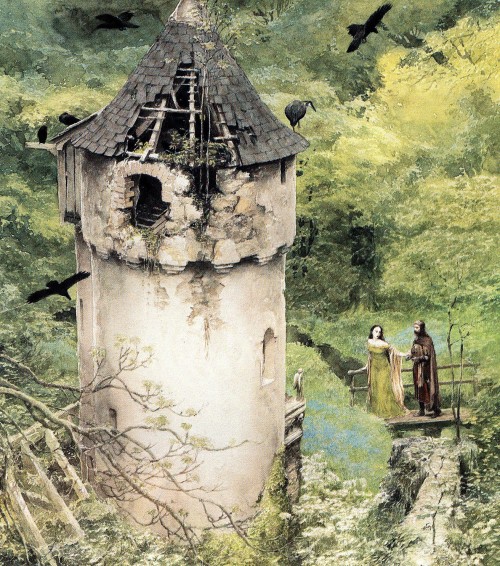
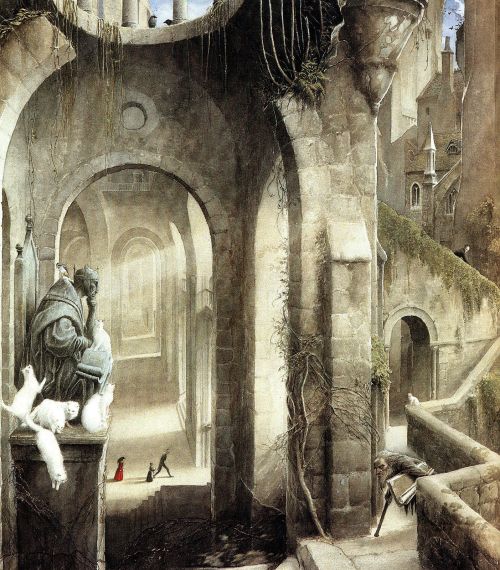


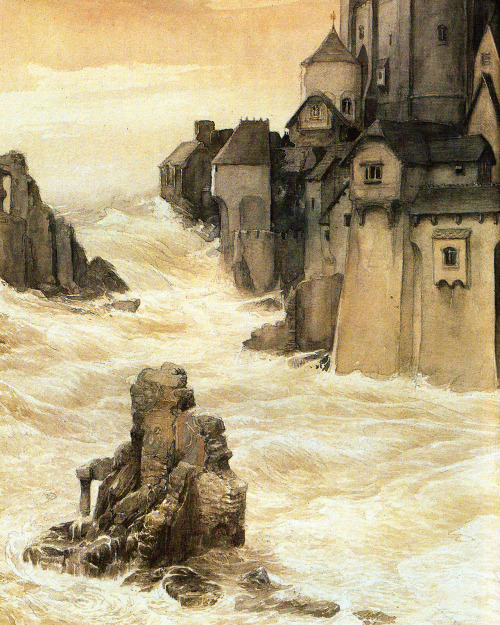
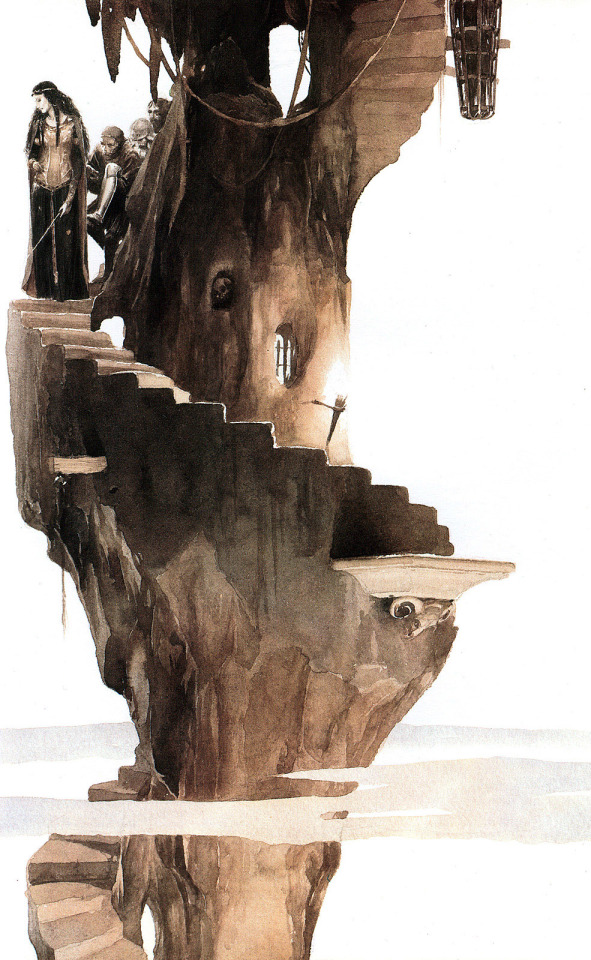
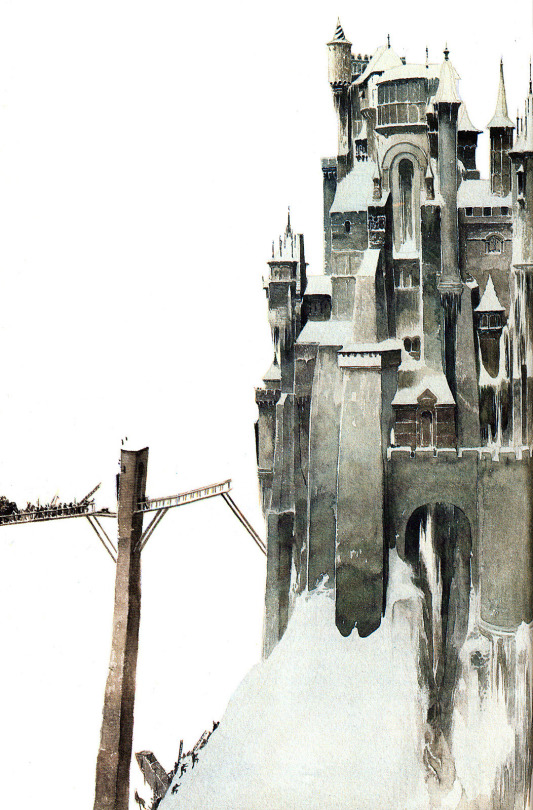
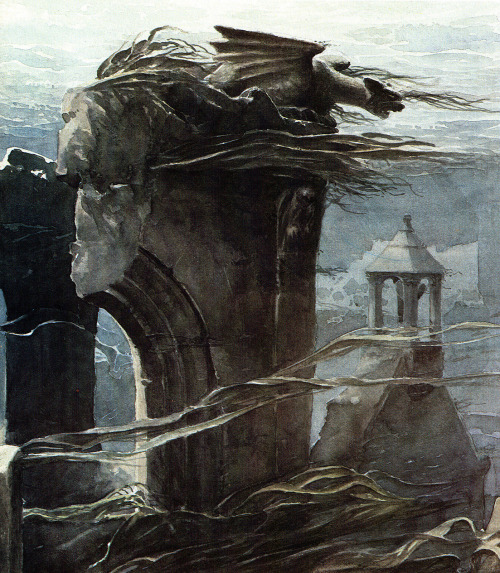
Castles - art by Alan Lee (1984)





The reduction gears and steam turbines under construction at the General Electric Plant, circa March 1942.

There are four sets of double reduction cross-compound geared turbines, with each turbine set driving a single shaft. “They offered almost 10-1 reduction to allow the turbines to run at much higher and more efficient rpm. These are some of the most critical components of the powerplant and one of the things which allowed long ranges in US battleships.“



Due to the date and the fact USS Iowa (BB-61) and USS Missouri (BB-63) were the only Iowa Class Battleships to receive General Electric gears and turbines, these are most likely for USS Missouri.


A man is shown deburring the edges of teeth with a file.
Note that they are double helix which eliminates axial thrust while providing the quieter running and increased strength of helically cut gears.
Photographed by Dmitri Kessel of LIFE Magazine. Identify by Peter Deforest.
LIFE Magazine Archive: 121941, 121944, 121942, 121943, 121940, 121945, 121946, 121949
-
 sheepwithbraces reblogged this · 1 month ago
sheepwithbraces reblogged this · 1 month ago -
 wise-white-owl liked this · 1 month ago
wise-white-owl liked this · 1 month ago -
 fancychaoscloud reblogged this · 2 months ago
fancychaoscloud reblogged this · 2 months ago -
 fancychaoscloud liked this · 2 months ago
fancychaoscloud liked this · 2 months ago -
 yenoodlethings liked this · 5 months ago
yenoodlethings liked this · 5 months ago -
 yenoodlethings reblogged this · 5 months ago
yenoodlethings reblogged this · 5 months ago -
 hogsbane liked this · 5 months ago
hogsbane liked this · 5 months ago -
 littledarknesgold liked this · 9 months ago
littledarknesgold liked this · 9 months ago -
 brickmastere reblogged this · 11 months ago
brickmastere reblogged this · 11 months ago -
 brickmastere liked this · 11 months ago
brickmastere liked this · 11 months ago -
 shaggyturkey liked this · 1 year ago
shaggyturkey liked this · 1 year ago -
 blitzenforcer reblogged this · 1 year ago
blitzenforcer reblogged this · 1 year ago -
 the-drawing-spacenerd06 liked this · 1 year ago
the-drawing-spacenerd06 liked this · 1 year ago -
 a-random-brick liked this · 1 year ago
a-random-brick liked this · 1 year ago -
 weirddollmaker liked this · 1 year ago
weirddollmaker liked this · 1 year ago -
 salmonofwisdom liked this · 1 year ago
salmonofwisdom liked this · 1 year ago -
 the-number-1-iono-fan liked this · 1 year ago
the-number-1-iono-fan liked this · 1 year ago -
 iminamanu reblogged this · 1 year ago
iminamanu reblogged this · 1 year ago -
 amonargets liked this · 1 year ago
amonargets liked this · 1 year ago -
 wmctalon reblogged this · 1 year ago
wmctalon reblogged this · 1 year ago -
 wmctalon liked this · 1 year ago
wmctalon liked this · 1 year ago -
 mrsketchy liked this · 1 year ago
mrsketchy liked this · 1 year ago -
 mrisopod reblogged this · 1 year ago
mrisopod reblogged this · 1 year ago -
 beepotatoe liked this · 1 year ago
beepotatoe liked this · 1 year ago -
 dogboyboyshorts reblogged this · 1 year ago
dogboyboyshorts reblogged this · 1 year ago -
 dogboyboyshorts liked this · 1 year ago
dogboyboyshorts liked this · 1 year ago -
 o-nexis liked this · 1 year ago
o-nexis liked this · 1 year ago -
 shadowmoses reblogged this · 1 year ago
shadowmoses reblogged this · 1 year ago -
 roberttheduke liked this · 1 year ago
roberttheduke liked this · 1 year ago -
 fieldofknives liked this · 1 year ago
fieldofknives liked this · 1 year ago -
 possibly-god reblogged this · 1 year ago
possibly-god reblogged this · 1 year ago -
 possibly-god liked this · 1 year ago
possibly-god liked this · 1 year ago -
 captainraye reblogged this · 1 year ago
captainraye reblogged this · 1 year ago -
 payloadofgeckos liked this · 1 year ago
payloadofgeckos liked this · 1 year ago -
 miss-chanandlershalamadingdong liked this · 1 year ago
miss-chanandlershalamadingdong liked this · 1 year ago -
 miss-chanandlershalamadingdong reblogged this · 1 year ago
miss-chanandlershalamadingdong reblogged this · 1 year ago -
 java3dition liked this · 1 year ago
java3dition liked this · 1 year ago -
 professional-trickster reblogged this · 1 year ago
professional-trickster reblogged this · 1 year ago -
 ghostofhallownest liked this · 1 year ago
ghostofhallownest liked this · 1 year ago -
 aerialworms liked this · 1 year ago
aerialworms liked this · 1 year ago -
 the-quasar-system reblogged this · 1 year ago
the-quasar-system reblogged this · 1 year ago -
 kvotheunkvothe reblogged this · 1 year ago
kvotheunkvothe reblogged this · 1 year ago -
 kvotheunkvothe liked this · 1 year ago
kvotheunkvothe liked this · 1 year ago -
 we-are-siphonophore reblogged this · 1 year ago
we-are-siphonophore reblogged this · 1 year ago -
 we-are-siphonophore liked this · 1 year ago
we-are-siphonophore liked this · 1 year ago -
 stradivariholmes reblogged this · 1 year ago
stradivariholmes reblogged this · 1 year ago -
 stradivariholmes liked this · 1 year ago
stradivariholmes liked this · 1 year ago -
 simianking liked this · 1 year ago
simianking liked this · 1 year ago -
 spatsandcravats reblogged this · 1 year ago
spatsandcravats reblogged this · 1 year ago -
 rosslynpaladin reblogged this · 1 year ago
rosslynpaladin reblogged this · 1 year ago
